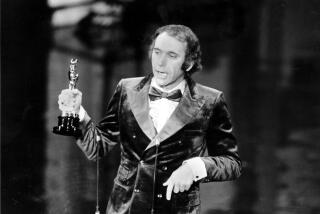The King of Contradictions : KING VIDOR, AMERICAN <i> by Raymond Durgnat and Scott Simmon (University of California Press: $32.50, 382 pp. 0-520-05798-8) </i>
- Share via
The title is, by design, touched with irony, overtones and undertones--a subtext in hand before we have even begun. For King Vidor was indubitably American, a pioneering film maker out of Galveston, Tex., who first tasted success photographing a hurricane there and who hied off to Hollywood when he was just 20 and the industry barely 10.
But the authors intend nothing so simple as a little four-square jingoism. Vidor was deeply in the American grain, but that is to say he embraced both multitudes and contradictions: Whitman and Emerson and not a little of Horatio Alger. He was populist and elitist, at various times a maverick and a (relatively) dutiful studio director. His tastes were both metaphysical and expensive.
He is not an easy director to categorize. His films are occasionally magnificent (e.g., his silents, “The Crowd” and “The Big Parade”) and sometimes mainstream ordinary. (It was in Vidor’s “Beyond the Forest” that Bette Davis snapped, “What a dump ,” as later celebrated by Edward Albee in “Who’s Afraid of Virginia Woolf.”)
Vidor has not been a favorite of the auteur theorists, possibly because they are uncomfortable with his inconsistencies, even though there is something of his signature to be found even in his lesser and most studio-dictated films. He could be collective-minded in his own “Our Daily Bread” and all for the rugged individualist in Ayn Rand’s “The Fountainhead.” Yet the work remained distinctively his.
The satisfaction of “King Vidor, American” is that the British critic Raymond Durgnat and the American critic Scott Simmon have at last given Vidor the detailed and thoughtful attention he deserves. There is an excellent filmography, including discussions of whatever is known of the many early Vidor films that have been lost. Only two of the films he made before 1920 still exist.
One or both of the authors had brief conversations with Vidor not long before his death, at the age of 88, in November, 1982, and they had access to some of his papers, including his annotated scripts. But the book is a biography only in the most rudimentary and glancing sense. It is a close study of the films, divided into six periods from the early silents to his epic “War and Peace” and his last feature, “Solomon and Sheba,” made in 1959 and marred by the death of Tyrone Power in mid-production and Power’s replacement by Yul Brynner.
Scholarly writing about films has a way of getting so tangled in its own rhetoric that its relation to what is visible on the screen grows very tenuous. Vidor himself once complained that a certain decipherer of his films kept trying to extract phallic overtones from a loaf of bread. “They were starving to death,” Vidor said with some exasperation.
Durgnat and Simmon do their own arm-wrestling with the languages of scholarship, and “iconography” gets a particularly hard workout. But for the most part the authors stay on the side of clarity and sanity, and their admiring sympathy for Vidor and his works is clear.
The writers and directors of Hollywood’s golden age had to work within the major studios’ vision of the audience and the audiences’ needs, expectations and limitations. The movies were (and to a considerable degree remain) a consensus medium, only rarely pushing hard against conventional expectations. A certain melancholy “what-if” thus hangs over many concluded careers. Orson Welles is perhaps the most conspicuous example, but Vidor is another, as the authors point out.
“How one regrets the cut-and-thrust a freer Hollywood might have allowed between (the visions of) Vidor and Kazan, a less grand Stevens, a more topical Wyler,” they say.
American society has changed even since Vidor stopped making films 30 years ago and has moved toward what the authors call a corporate conservatism. But there is still another American spirit, they argue: “Populist and enthusiastic, pragmatic and religious, open to visions and impulses of change. Vidor’s work remains its classic expression. . . . He sought to ally what is ferocious with what is generous in the American ethos.”
The need remains for a major, full-scale biography of King Vidor, but there now exists this occasionally awkwardly expressed but pensive and even passionate analysis of his work--contradictions and all.
More to Read
Only good movies
Get the Indie Focus newsletter, Mark Olsen's weekly guide to the world of cinema.
You may occasionally receive promotional content from the Los Angeles Times.










